Even 6-figure BMW 750iXL halted by ice, tires
By John Gilbert
Remind me, someone, to plead with the press-fleet powers at BMW to send me the new BMW 750iL for a second test-drive week, after the persistent snow and ice of this never-ending winter finally cash in their chips. As it is, the chance to experience the many wonderful features of the car, which is BMW’s flagship of luxury and class, was undone by a couple of snowstorms and some easy-slip tires.
It’s not as though I didn’t get a chance to test the 750 extensively. All the things I experienced with the car were very impressive, even for a car whose sticker price topped the $118,000 mark. As usual, the lofty price of a BMW can also be said to be worth it, based on the level of technical refinement and engineering brilliance. This car had the 4.4-liter V8, with more power than any normal driver could ever need, and all the luxury features imaginable, and a few beyond imagination.
But one characteristic out of the car-maker’s control was a major flaw, in the Great White North. The tires BMW put on the car were Pirelli P7 Cinturato by designation, and I know from past experience they are among the very best tires in the world on dry pavement, and for high-speed maneuvering. My past experience with those tires in Minnesota winter driving is less extensive, limited to the BMW X1 crossover, and in both cases, the low-profile beauty of those tires, and their ability to stick like glue to a dry track at high speed, became the farthest thing from a driver’s mind after a snowstorm.
As i was driving the 750, I couldn’t help but be reminded of the huge snowfall that hit the Northeast back in late February, I think it was, burying much of Massachusetts, New Hampshire and points north under 27 inches or snow of snow. A storm of that magnitude would be incredible wherever it happened, but it wouldn’t have commanded the national news and weather programs on network and satellite. Every time you turned on the television, you couldn’t escape the newscasters, inside their parkas, doing their obligatory reports while standing outside during the most intense parts of the blizzard.
A woman on either CNN or The Weather Channel was in a convenience store/gas station parking lot, and the swirling snow in the background made it appear to be on the edge of the Arctic Circle. She noted a car behind her spinning helplessly and unable to get out of the unplowed lot. Finally, two or three large fellows pushed and pushed and finally the free-spinning Acura TL got enough momentum to disappear out on the streets. Moments later, a subcompact, possibly a Nissan Versa or Toyota Yaris, came around the gas pumps and went by, covered with snow, and also spinning its front drive-wheels. “Here comes a little tiny car,” she said, “which, of course, will have no chance getting through this snow because it’s so light.” With that, the little car kept on churning and made it on out of the lot.
Tires matter. True, they matter for high-performance speed and cornering, and they also matter to the mainstream for long wear and smooth cruising. But they matter most in order to propel your car safely through the worst of foul-weather storms, where going off the road or being unable to get to your destination can leave you marooned. And the tires that work in one extreme condition are completely unsuited for the other extreme. Being stationed in Northern Minnesota, where such winter storms are common — and seem to be never-ending well into April of this particular year — even untrained drivers are aware of the need to get traction in wintry driving, which is mandatory for getting to work, if not simple survival. For the rest of the world, or our country, the masses may be totally unaware of the importance of worthy all-season or snow tires. And national reports on television that are erroneous don’t help.
The Acura TL in the live shot, for example, has front-wheel drive, but may well have had the factory-issue Michelin tires that are so good in dry weather and for long wear, but have a hard compound that refuses to earn traction on ice or snow. And the woman’s editorial comment about how “little cars” have no chance of getting through prove that not only experience but a shred of common sense is important before claiming that a cars size and weight is all that matters. The small car in question had front-wheel drive too, and even though it’s light, it has its weight centered over the drive wheels, and with adequate all-season tires it can keep churning on icy roads or deep snow.
I’m not blaming The Weather Channel for sending out an attractively snowbanked, on-the-scene reporter who was unaware that the right tires can make a front-wheel-drive car get through such conditions, regardless of its weight, but to issue such misleading statements is as ill-advised as it would be to ask me for an impromptu comment on the difference between an occluded front and that Alberta Clipper coming down from the northwest.
When the BMW 750iXL was delivered to my home, the fellows driving it up from Chicago remarked about how tough a drive it was, including their need to get towed out of a ditch at one point on Interstate 94. One of the fellows wondered about a rear-wheel-drive BMW being sent to Duluth, Minnesota, at that time of winter. I agreed, anticipating the upcoming challenge just to get out of my 100-yard driveway, but as I walked around the rear of the shiny new Beemer, I noted the sign said “750iXL,” with the added symbol for “X-drive,” which meant the car, indeed, had BMW’s exceptional X-drive all-wheel-drive system.
After slithering out of my driveway, and for several days using an experienced sequence of vectors to keep the 750 heading in approximately the right direction, I realized that the P7 Cinturatos were committed to not spitting out snow and ice from their tread, or to retain any flexible hopes of sticking to the slippery road surfaces in the cold, that their lack of traction nullified the inherent advantages of all-wheel drive.
Between snowfalls, and after plowing, the BMW 750iXL was pure pleasure. In the front, you are encapsulated in luxurious and supportive seats that adjust every which way. A heads-up display shows up on the windshield and can display your speed, and the speed limit. No more saying you didn’t know how fast you were going, or what the limit was. The lane directional control gives you a staccato vibration on the steering wheel if you start to wander into the next lane, or across the center line. The iDrive control for the many connective features has become refined enough to be less of a nuisance to operate, and there are numerous little storage bins located wherever there seems to be an unused space. A large sunroof is pleasant, and the two glove compartments are a good use of space, with one down by the passenger’s knees and the other above the midpoint of the dash.
Part of the week, we spent driving with my younger son, who is 6-foot-3, which makes the “L” in the 750iXL a real benbefit,. He remarked about how large and spacious the rear seat was, with a comforting, wedgy footrest under the back part of the front seats. Also, a cooler adds an interesting feature, and the rear seats have controls for heat and cooling, and even a massage feature.
- Leather and wood abounds.
The controls are clearly defined for the driver, in their round housings, and a screen that is 8 inches long and 4 inches high is filled with your information of choice. If you need audio, climate control, or a navigation screen, you can select it. You can even do a split screen that has a map on one side and audio controls on the other.
Aside from the no-winter-traction tires, the only thing that is easily faulted is the continuation of the shift lever design, which allows you to drop the lever from reverse, to neutral, to drive, and to a manual setting that encourages you to hand-shift the 8-speed automatic. So you stop to run inside for a quick errand, and you flip the shift-lever as far forward as it will go. If you assume you’re in park, you’re wrong. To engage park, you stop, then you gently but firmly push down on the button on top of the shift lever, and it will click into park. Maybe. Several times during my week with the 750iXL I did exactly that, thinking I was in park, and as I got one foot out the door, the car started to roll backwards.
That can ruin your day. Each time, I put my right foot on the brake and tapped the button to get park. Problem is, no matter how firmly you hit the button, it seems to refuse to engage park until you do it a second time. Maybe it’s just to see if you’re paying attention. If you have a keen eye, you might be able to spot the extremely small “P” replacing the “D” or the “R” in the quite small box in the tachometer, to make sure you’re in park. You learn quickly not to exit from the car quickly, and to make sure you’re caught park, just so your $118,000 beauty doesn’t end up rolling through a neighbor’s hedge, or enter a shop across the street via the plate-glass window.
You can get used to that, with repeated tries, but it makes you unnecessarily nervous every time you try to park. My question is why? Why would a company as advanced in engineering as BMW want to make such a simple thing as stopping and shifting into park such an adventure?
That’s the same question I have for the tires. BMW is justifiably proud of its exceptional ability to make cars with uncompromising handling excellence. For that reason, apparently, the company tells its press fleet companies that they shall not replace the tires on the BMW cars, because BMW is so proud of the choices it’s made for optimum performance tires. Our experience with the Pirelli P7 Cinturato tires on ice in Duluth, Minnesota, begged to have a company official come directly from Munich to observe.
On one of the days of our week with the car, we’d had one of the two major snowstorms of that particular week, and I suggested my wife, Joan, should drive the 750iXL downtown and back that day. We’d had our driveway plowed out, and the roads were all plowed, and it was a bright sunshiny day, so all should be well. I picked up a Mitsubishi Lancer GT for a test drive that same morning, and I got home before Joan. As I pulled into the driveway, I noticed that the sun had melted the snow down to the asphalt in a little spot at the far end of the driveway, so I parked back a bit, to give the sun more room to work. My plan was to go inside and write for a while, then come out and move the car ahead so Joan could swing by with the 750iXL and park up by the garage. But I kept working, and forgot about moving it.
Joan came home without difficulty, pussyfooting around because of my warning about the tires, and she turned into the driveway and slowly made her way forward. Suddenly she realized there might not be room for her to pull around the Lancer on the left, so she tapped the brake. The big BMW immediately reacted, and slid in an 80-degree vector to starboard — right off the edge of the driveway and nestled deeply in a snowbank. She fetched me, and we worked over and over, shoveling, chipping ice, and shoveling, putting salt down, and rocking the BMW forward and back, slightly though that may have been.
Finally we called our neighbor, Greg, the guy who seems to enjoy plowing driveways. He came up with his son and we all tried to push and rock the car free. Finally we gave up, and Greg hooked a fabric tow chain to the rear axle and, with his Ford F150 pickup gently doing the job, pulled the BMW out of its snowy encampment. I like Bridgestone Blizzaks, and I love Nokian WRG2s, and I can think of various Bridgestone, Goodyear, Dunlop, Continental and other tires that will work on ice and snow. Even Michelin has come up with an all-season tire that is functional. But if you demand, the way BMW does, to keep your Pirelli P7 Cinturato slicks on your Beemer in wintertime, make sure you have a shovel, some sand, and a tow rope in your trunk at all times.
While I loved the car, and hated the tires, sometime after May arrives, I’m hoping my plea is answered to get the chance for another test of the BMW 750iXL, when the last trace of snow is gone, and I can more fully appreciate the car’s dynamic excellence.
Comments
Tell me what you're thinking...
and oh, if you want a pic to show with your comment, go get a gravatar!


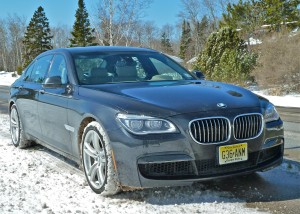
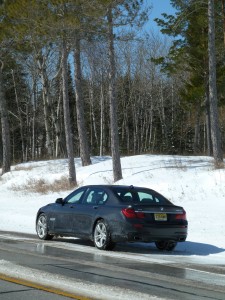
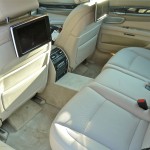
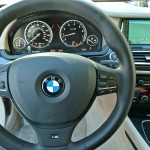
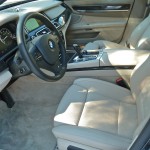

 John Gilbert is a lifetime Minnesotan and career journalist, specializing in cars and sports during and since spending 30 years at the Minneapolis Tribune, now the Star Tribune. More recently, he has continued translating the high-tech world of autos and sharing his passionate insights as a freelance writer/photographer/broadcaster. A member of the prestigious North American Car and Truck of the Year jury since 1993. John can be heard Monday-Friday from 9-11am on 610 KDAL(www.kdal610.com) on the "John Gilbert Show," and writes a column in the Duluth Reader.
John Gilbert is a lifetime Minnesotan and career journalist, specializing in cars and sports during and since spending 30 years at the Minneapolis Tribune, now the Star Tribune. More recently, he has continued translating the high-tech world of autos and sharing his passionate insights as a freelance writer/photographer/broadcaster. A member of the prestigious North American Car and Truck of the Year jury since 1993. John can be heard Monday-Friday from 9-11am on 610 KDAL(www.kdal610.com) on the "John Gilbert Show," and writes a column in the Duluth Reader.